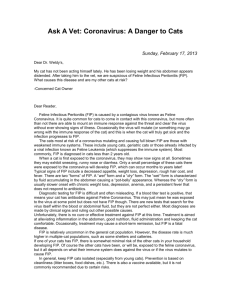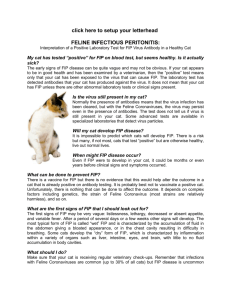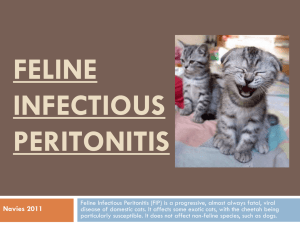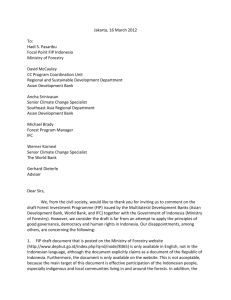Understanding Feline Infectious Peritonitis
advertisement
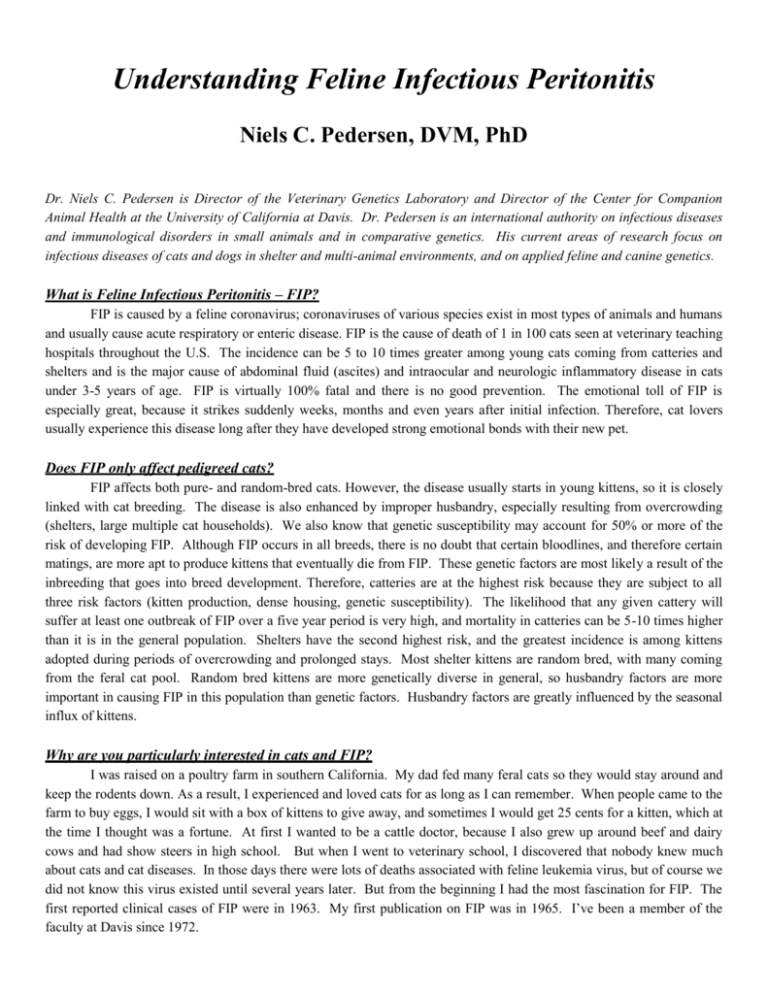
Understanding Feline Infectious Peritonitis Niels C. Pedersen, DVM, PhD Dr. Niels C. Pedersen is Director of the Veterinary Genetics Laboratory and Director of the Center for Companion Animal Health at the University of California at Davis. Dr. Pedersen is an international authority on infectious diseases and immunological disorders in small animals and in comparative genetics. His current areas of research focus on infectious diseases of cats and dogs in shelter and multi-animal environments, and on applied feline and canine genetics. What is Feline Infectious Peritonitis – FIP? FIP is caused by a feline coronavirus; coronaviruses of various species exist in most types of animals and humans and usually cause acute respiratory or enteric disease. FIP is the cause of death of 1 in 100 cats seen at veterinary teaching hospitals throughout the U.S. The incidence can be 5 to 10 times greater among young cats coming from catteries and shelters and is the major cause of abdominal fluid (ascites) and intraocular and neurologic inflammatory disease in cats under 3-5 years of age. FIP is virtually 100% fatal and there is no good prevention. The emotional toll of FIP is especially great, because it strikes suddenly weeks, months and even years after initial infection. Therefore, cat lovers usually experience this disease long after they have developed strong emotional bonds with their new pet. Does FIP only affect pedigreed cats? FIP affects both pure- and random-bred cats. However, the disease usually starts in young kittens, so it is closely linked with cat breeding. The disease is also enhanced by improper husbandry, especially resulting from overcrowding (shelters, large multiple cat households). We also know that genetic susceptibility may account for 50% or more of the risk of developing FIP. Although FIP occurs in all breeds, there is no doubt that certain bloodlines, and therefore certain matings, are more apt to produce kittens that eventually die from FIP. These genetic factors are most likely a result of the inbreeding that goes into breed development. Therefore, catteries are at the highest risk because they are subject to all three risk factors (kitten production, dense housing, genetic susceptibility). The likelihood that any given cattery will suffer at least one outbreak of FIP over a five year period is very high, and mortality in catteries can be 5-10 times higher than it is in the general population. Shelters have the second highest risk, and the greatest incidence is among kittens adopted during periods of overcrowding and prolonged stays. Most shelter kittens are random bred, with many coming from the feral cat pool. Random bred kittens are more genetically diverse in general, so husbandry factors are more important in causing FIP in this population than genetic factors. Husbandry factors are greatly influenced by the seasonal influx of kittens. Why are you particularly interested in cats and FIP? I was raised on a poultry farm in southern California. My dad fed many feral cats so they would stay around and keep the rodents down. As a result, I experienced and loved cats for as long as I can remember. When people came to the farm to buy eggs, I would sit with a box of kittens to give away, and sometimes I would get 25 cents for a kitten, which at the time I thought was a fortune. At first I wanted to be a cattle doctor, because I also grew up around beef and dairy cows and had show steers in high school. But when I went to veterinary school, I discovered that nobody knew much about cats and cat diseases. In those days there were lots of deaths associated with feline leukemia virus, but of course we did not know this virus existed until several years later. But from the beginning I had the most fascination for FIP. The first reported clinical cases of FIP were in 1963. My first publication on FIP was in 1965. I’ve been a member of the faculty at Davis since 1972. What is the History of FIP? FIP was first recognized as a specific clinical entity in the late 1950’s. This timeline was based on decades of meticulous necropsy records kept by pathologists at the Angell Memorial Animal Hospital. There was a steady increase in the incidence of the disease in the 1960’s onward, and it is currently one of the leading infectious causes of death among young cats from shelters and catteries. The reason for the sudden emergence of FIP is not known, but there are at least two possible explanations. First, it is noteworthy that FIP appeared within a decade of the initial descriptions of transmissible gastroenteritis (TGE) of pigs in North America. The causative virus of FIP is closely related to TGEV of pigs and canine coronavirus (CCV), although they are still genetically distinguishable. However, mixtures between these three viruses are known to occur. At least one strain of canine coronavirus can induce mild enteritis in cats and enhance a subsequent infection with FIPV, indicating a special closeness to feline coronaviruses. Therefore, CCV may be a more likely parent of FECV in this scenario. Another related possibility is that the FIP mutation occurs only in a relatively new strain of FECV, and that this new strain only evolved in the 1950’s. Coronaviruses such as FECV are continuously mutating as a result of the manner in which their genetic material (RNA) is replicated. Therefore, genetic change, either among themselves or through genetic mixing with closely related coronaviruses from other species, could have either allowed a coronavirus of another species to take up host in cats or to alter a strain that existed prior to the 1950s. An alternative non-genetic explanation may involve changes in how cats were viewed as pets and their husbandry. There was a dramatic shift in the status, keeping, and breeding of cats as pets after WWII. The numbers of pet cats greatly increased, purebreeding and cattery rearing became increasingly popular, and more cats, and in particular kittens, found themselves in shelters. These large multiple cat indoor environments are known to favor feline enteric coronavirus (FECV) infection and FIP. Interestingly, feline leukemia virus (FeLV) infection also became rampant among indoor multiple cat households during this period, and FeLV infection was a significant enhancing factor for FIP until it was pushed back into nature as a result of testing, elimination/isolation, and eventual vaccination in the 1970s and 1980s. How is the coronavirus spread between cats? Coronviruses are ubiquitous among all cat populations and the principle one of cats is correctly referred to as feline enteric coronavirus (FECV). FECV is present in virtually all catteries with 6-8 or more cats and in 40% or so of the kittens relinquished to shelters. The enteric virus in the cat population lives in the digestive tract and is shed in feces. Cats can shed the virus for 4-6 months, or for a year or more in a continuous or intermittent fashion. Recurrent infections are also common. FECV is easily spread through litter and litter dust, and can be carried from place to place on people’s bodies and clothing. Virus contaminated material is easily transferred to the paws and fur of susceptible cats and then ingested during grooming. Kittens are infected by other cats at about 9-10 weeks of age, although one report places it as early as 3 weeks. How does the coronavirus turn into FIP? FIP is caused by a mutation of FECV, which is ubiquitous among cats. Although the mutation of FECV to FIPV is common, it is fortunate that only a small percentage of cats exposed to this mutant virus will get FIP. FECV is undergoing continuous mutation and several genetic forms of the virus may co-exist in the same animal at the same time. Most of these mutations have very little effect on the behavior of the virus and merely serve to genetically reflect the region from which the virus originated. However, mutations that inhibit or knock out the function of a certain small gene (called 3c) have a pronounced effect on the biologic behavior of the virus. All known isolates of FIP virus that we have studied, and that have been reported by others, have various types of mutations in the 3c gene. Mutations within the 3c gene with the potential of causing FIP are common. One study indicated that 20% of the kittens infected with FECV will produce an FIP mutant. Of course, only a fraction of the mutants will go on to produce FIP, depending on host resistance factors (genetic or non-genetic). This FECV to FIPV genetic change is referred to as the internal mutation theory. The internal mutation theory has two corollaries: 1) that each cat that develops FIP, even if it is a littermate, closely related or commonly housed, has a different mutation in the 3c gene, and 2) that horizontal (cat-tocat) transmission of the FIPV mutant is uncommon. We have reconfirmed corollary 1, and have confirmed corollary 2 in concept but not in fact. Reconfirmation for the internal mutation theory came from a recent outbreak in three kittens in a litter of Scottish Folds and in a half-sibling from a second litter. All four FIPVs had significant, but different, mutations in their 3c genes, but were closely related in all of their other genes to one of two different FECVs detected in the feces of one of the kittens. We have found that many cats with FIP are in fact shedding the same FIPV in their feces that is in their diseased tissues. However, for some reason, it does not appear to be highly contagious. What are the signs of FIP? Signs of FIP arise weeks, months, and in rare cases years after initial infection. During this quiescent stage, the cat may be asymptomatic or suffer from vague signs such as stunted growth or increased susceptibility to other common infections. Many breeders and even clinicians believe that FIP can cause upper respiratory disease signs during its early stages; this is not technically correct, because upper respiratory disease is usually caused by herpesvirus, chlamydophilla, mycoplasma, etc., and not directly by FIPV. With time, many cats win their battle with this infection, while others lose. However, “losing the battle” may occur over a very long period of time; only terminally, when the cat’s defenses collapse, do the more characteristic signs of FIP develop. This capitulation to the virus explains why cats with FIP seldom recover, because a loss of immunity is extremely difficult to reverse. Cats who develop clinical cases of FIP may initially show nonspecific symptoms such as loss of appetite, depression, rough coat, weight loss, a fluctuating antibiotic resistant fever, and increased susceptibility to secondary infections (such as respiratory disease). More specific signs of FIP vary depending on the form of the disease (wet vs. dry) and the organs that are involved. The most common form of the disease is referred to as “wet FIP.” Wet FIP is caused by inflammation of the linings of the abdominal viscera, and less commonly of the thoracic organs. This inflammation exudes large volumes of a characteristic mucinous, yellow-tinged fluid (exudate). Therefore, the major clinical sign in the wet form of FIP is ascites and abdominal distension (abdominal involvement) or dypnea (thoracic involvement). FIP can also take a more chronic form referred to as “dry FIP.” Dry FIP, as the name implies, is not associated with fluid accumulations in the abdomen or chest, but rather with more localized masses in the kidneys, spleen, liver and terminal bowel, eyes, and the linings of the lungs and heart, and central nervous system. Uveitis (intraocular inflammation) can affect the eyes, making them look cloudy and changing the color of the iris. Inflammation can enter the brain and spinal chord and cause a spectrum of progressive neurologic abnormalities. FIP accounts for over one-half the cases of inflammatory intraocular and nervous system disease in cats under 3-5 years of age. Although unappreciated in the past, we now know that cats in the terminal stages of FIP are often severely immunocompromised. This explains why common bacterial infections may complicate the disease picture in cats with FIP. Is FIP contagious? Cats with FIP do not appear to be very contagious to cats that they come in contact with. Although this has been based mainly on clinical observations, it has also been confirmed by laboratory studies. We have not observed contact transmission in experimental settings. Furthermore, cat-to-cat transmission implies that every FIPV isolated from a group outbreak of FIP will be genetically identical in its 3c gene mutation. As I mentioned earlier, we have yet to observe this. However, we now know that FIPV is present in the feces of most cats with FIP, so horizontal transmission is theoretically possible, although very uncommon. How do genetics, stress, and other infections play a role in FIP? FIP is not a breed specific disease, but does follow certain bloodlines within breeds. Heritability accounts for about 50% of the incidence. Environmental factors influence the other half. The age of the cat at the time of initial FECV exposure plays an extremely important role in whether a cat dies from FIP. Kittens usually began shedding FECV at around 9-10 weeks of age, which places their actual exposure a few days to a week earlier. The immune system of the kitten is rapidly maturing during the period between 6-16 weeks of age. Therefore, the first exposure of most cats to FIP causing mutants occurs during a time period when their immune systems are still developing. This lack of development enhances the likelihood of a FIPV mutant to gain a strong foothold into the body. Just as there is an age susceptibility, there also appears to be an age resistance. FIP is seldom seen in cats over 3-5 years of age, and most cases occur before 16 months of age. In the 1970s, when tests for FeLV became available, we discovered that one third to one half of all cats with FIP were also FeLV positive. In later experiments, we showed that cats that had resisted infection with FIP virus would develop FIP shortly after being infected with FeLV. This meant that FeLV infection somehow interfered with the ongoing immunity to FIPV. With the elimination of FeLV as a major infection of cats, we no longer see such a strong relationship, especially among catteries and shelters where FeLV control programs are in effect. Most cats with FIP in the present age, with the exception of a few household pet cats, are not FeLV infected. Anything that stresses cats can depress immunity and also increase the likelihood that FIPV will establish itself in the body. Stress may also allow an FIPV that is being successfully contained to become active. The effect is even more powerful if the stress occurs at or shortly after the time the cat is exposed to the virus. Stressors can include overcrowding, weaning, spaying or neutering, other infections, being placed in a new and strange household, adding new cats to a household, shipping cats to new owners or other catteries, or stresses of pregnancy, parturition and lactation. Disease caused by feline herpes virus and other common upper respiratory pathogens are good indicators of cattery or shelter stresses. If a cattery or shelter is having a lot of problems with these upper respiratory infections, it is likely that they will also have problems with FIP (especially if the genetics are unfavorable as well). For instance, an area SPCA had a huge FIP problem in the kittens they were adopting out. It was kitten season and the facility was overcrowded with cats and they had to stay for longer periods awaiting adoption. There was also a lot of upper respiratory disease. After limiting their intake of cats, overcrowding was eliminated and cats were adopted after shorter stays. The FIP problem decreased to negligible levels, as did the respiratory infections. Is there a definitive test for diagnosing FIP? The diagnosis of FIP should be relatively simple, given its affinity for younger cats, its strong tendency to involve catteries and shelters, the typical physical and historical findings, and numerous characteristic laboratory abnormalities. Nonetheless, it somehow remains one of the most difficult of diagnoses for many veterinarians. The truth is that veterinarians have little trouble in placing FIP high, or at the top, of their diagnostic list, but have great difficulty, and even reluctance, in confirming their diagnosis. This is probably because FIP is viewed as a death sentence, and we are reluctant to confer such a sentence without certain proof. Although a definitive test result would assist decision making, a certain diagnosis can be based on cumulative odds rather than a single, simple, definitive test result. A young cat from a cattery or shelter with chronic uveitis and/or neurologic signs, high serum proteins, hyperglobulinemia and hypoalbuminemia, fluctuating antibiotic unresponsive fever, leukocytosis with a lymphopenia, and an anemia of chronic disease can have no other disease than dry FIP based on odds alone. Likewise, the same cat with similar history and laboratory findings, but with yellow-tinged, mucinous, inflammatory ascites is highly unlikely to have any other disease than wet FIP. It is interesting that a cattery owner or cattery worker is often the one to cue in on the correct diagnosis based on the simplest of observations and intuition. In an attempt to reach the elusive definitive diagnosis, veterinarians rely on dozens of tests that claim to highly correlate with the disease or to be diagnostic. I do not have time to go into the dozens of tests that fall into this category, or the good tests that are improperly done, or improperly interpreted, that lead to misleading positive or negative results. In truth, the only good definitive way to diagnose FIP is to identify the virus in macrophages within lesions or ascetic/pleural fluid by a procedure called immunohistochemistry. PCR would work equally well on diseased tissues or fluids, but many of the current tests are improperly designed and conducted and frequently yield misleading results. In some cases, the proper fluid or tissues cannot be obtained pre-mortem. However, there is no excuse for not doing such definitive tests post-mortem. This brings me to a final point, a necropsy should be done by a qualified veterinary pathologist on any cat that requires a proper diagnosis. However, even veterinary pathologists will hem and haw about a definitive diagnosis, even when faced with incontrovertible historical, clinical and histological evidence. Make them make a definitive diagnosis, either based on proper reading of the odds or by doing immunohistochemistry on lesions. What is the best way to care for a cat that has FIP? There is currently no cure for FIP; therefore, the primary concern needs to be making the cat comfortable and deciding when to quit. Cortisone can help reduce inflammation and encourage appetite. Good nutrition, hydration and non-stressful environments are also important, but in almost all cases they serve only to prolong the inevitable. Therefore, we will encourage some owners to go with symptomatic treatment, but only if the animals are not suffering. There have been reports that the feline interferon omega is effective in combating FIP. We actually tested it against FIP years ago and it did not work. Fortunately, a double blind, placebo controlled study was recently reported from Europe on the use of interferon omega in treating FIP. Cats receiving this very expensive treatment fared no differently than placebo treated cats. This will hopefully stop the use of this treatment in the US and other countries, although some people still believe more in anecdotes than scientific trials. Unfortunately, veterinary medicine is filled with anecdotal treatments. How do you know when to euthanize a cat that has FIP? This is a decision only you can make, and it is a difficult one. I would never suggest euthanizing a cat, even with FIP, as long as it looks and acts fairly normal. Miracles do happen, but they can’t happen unless they are provided time to happen. However, I also cannot argue with those owners that decide to end suffering at an earlier stage, given the grave prognosis. I always tell owners to decide to put an animal down when it no longer takes pleasure in life. But cats can feign health to the last moment and you often regret in retrospect not making the decision earlier. I did the same thing with one of my cats that was dying of cancer. He actually was dead one morning, even though I still thought he had time to live and seemed reasonably content. There is also a myth that if a cat is still purring that it is still enjoying life. But research has shown that cats purr even when in extreme pain, it is another way that they mask illness. After you have had FIP in an environment, how long should you wait before a new cat or kitten is brought in, and what other steps should you take? Remove any cat related items that you cannot wash or disinfect, such as a scratching post or soft toys. Clean and disinfect everything else in the environment that you can. Time will take care of the rest, because viruses of this type are not long-lived in the environment. We generally recommend a couple of months. These steps are undoubtedly an overkill when it comes to FIP, but these recommendations are standard for most infectious diseases and we try to keep everything simple and consistent. If FIP occurs in a cattery, how do you decide whether and which cat to spay/neuter? We know that genetics play a strong part in FIP - at least 50% of the incidence or more has a heritable component. We know that susceptibility is carried both in paternal and maternal lines, but we have suggested, at a minimum, that paternal lines that throw kittens that die from FIP not be used for breeding. This is because toms breed multiple queens and sire dozens or hundreds of kittens, and have the greatest influence on how bloodlines are developed. This is true of a lot of diseases – the “Founder effect.” If females are genetically weak, and bred to weak toms, that is when you get into problems. If toms are genetically strong, and queens are genetically weak, the male’s resistance genes seem to mask this weakness. The best scenario is to not breed either susceptible toms or queens, but not using problem toms is the best possible alternative in the interest of doing the most with the least disruption of breeding practices and bloodlines. However, if there are multiple losses from FIP in a litter, remember that susceptibility comes both from the paternal and maternal lines. It’s also important to consider the cat – if you believe the cat may be at risk for FIP, avoiding the stress of being a breeding cat may help prevent the disease for that individual. If one kitten in a litter has FIP, how likely is it that other littermates will be affected as well? We know that if one kitten in a litter gets it, that the others are several times more likely, but this is not absolute. If the overall incidence is 5% across the spectrum of young cats produced in a cattery, it could be 10-50% or higher among the remaining littermates. I have seen one kitten in a litter of 6 killed by FIP and I have also seen 5 out of 6 develop the disease. Time is the only thing that will determine the fate of healthy siblings. Sometimes both bacterial and viral infections exist in a cat with FIP – which came first? It is really impossible to say which came first, because it is like chickens and eggs. A given cat could have had some underlying immunosuppression that made it susceptible to a number of common feline pathogens as well as FIP. It is also possible that the cat suffered from FIP for a long time and that this was the cause of immunosuppression and the other infections were secondary. What is the best way for breeders to prevent FIP? Resistance is the ability of the immune system to cope with a disease. We know that 50% of the incidence is heritable, and we know that resistance (or susceptibility) factors exist in both toms and queens. However, culling problem toms is the simplest genetic procedure to reduce incidence. Toms produce far more litters and kittens than queens, and therefore have a much bigger effect on the disease. Good judgment and husbandry will influence the other 50% of the equation. Pick the largest and strongest in a litter to keep for breeding and avoid kittens that are slow growing and prone to other infections. Spay and neuter cats that throw FIP and adopt them into good homes. Avoid stress and overcrowding; maintain only those cats deemed necessary for your breeding program and chose mating wisely to limit kitten numbers. Keep cats in small, separate groups. Consider isolating the kittens from the mother at weaning to avoid exposure to the virus. Don’t mix very young kittens with older kittens. If you can limit coronavirus exposure until 12-16 weeks of age, when the immune system is better developed, the likelihood of developing FIP will be less. Follow accepted protocols for vaccinations and practice good husbandry to limit other infections. Clean and disinfect cages and litter boxes regularly. The corona virus is easily killed by bleach and other disinfectants. Is it possible to have a corona virus free cattery? This is extremely difficult, because the virus is ubiquitous in the environment and easily spread by cats and on people. Isolation of queens and early weaning has been touted in the UK and is used in the US. However, UK catteries are small and such a program can only succeed in smaller catteries and with exceptional isolation facilities and quarantine procedures. Moreover, even if you could produce a virus free cattery environment, the moment a kitten or cat goes to new environments such as a pet home it will most likely be exposed to FECVs. Therefore, we do not recommend this procedure unless simpler husbandry practices totally fail to reduce the problem. Isn’t there an FIP Vaccine? A vaccine was developed and is available. However, it has to be used in kittens at least 16 weeks of age (most cats are already exposed to coronavirus at this age), it is not effective in cats already exposed to coronavirus (which is most cats), it is not effective against the common serotype of FIPV, and even when all factors are optimal, it has low efficacy. In short, it does not work in the environments where it is needed most (catteries and shelters) and is not justified in older pet cats where FIP is hardly seen. We do not recommend its use. Why is there hope now for progress on finding ways to prevent and treat FIP? It is true that there is still no cure, or totally effective prevention. But we understand the virus and the infection much better now. We have new tools that allow us to look at viruses at the molecular level. Any knowledge about the virus and how the host cat responds to it will have influence down the road. The Feline Genome has been sequenced and in 2 years it will be complete. We will be able to identify viral genes responsible for causing disease (which will facilitate antiviral drug development) and host genes that confer resistance/susceptibility (which will facilitate genetic control). There are only two ways to affect the corona virus at the current time – through husbandry and careful matings. Husbandry techniques can help prevent the spread of the virus – a great deal of research has been done and continues in this area at the Shelter Medicine program at Davis. Understanding how the immune system affects both resistance and the form of the disease (wet vs. dry) will be important. Immunity studies focus on how to modify the immune system’s reaction to the virus. Understanding how to block inflammation and the development of anti-viral drugs would be ways we could fight it. There is no reason why these can’t be developed. In fact this was happening following the appearance of the severe acute respiratory syndrome (SARS) - another coronavirus disease, but of humans. However, this research was curtailed when SARS failed to spread to the general population and was easily contained. But it made human researchers interested in the corona virus. Drugs could be developed and used in FIP with some effect - like HIV/AIDS it could become a manageable disease If we can discover the genetic basis for susceptibility, we will be able to offer genetic testing and breeders can breed out the trait over several generations, while preserving valuable bloodlines. This is exactly what breeders are doing with many other genetic diseases, such as polycystic kidney disease in Persians and breeds with Persian blood. How can Burmese and Birman breeders help with FIP research? Genetic research has great potential, but it takes time and money. Because FIP is a purely animal disease, there will be limited funding from sources such as the NIH. It’s important to start banking DNA and assembling pedigrees showing relationships between affected and healthy cats. Breeders should not be ashamed of FIP. If you breed enough cats, long enough, you will experience FIP. The reluctance of breeders to talk about it has been a huge detriment to FIP research. For instance, if every one would cooperate, we could determine whether or not there is a genetic basis for FIP resistance or susceptibility in rapid time. If there is a genetic basis, we could then determine the gene or genes involved and develop tests to predict which cats to breed or not to breed. Fortunately, some breeders are now coming forward and cooperating in raising funds for FIP research and providing information and materials (such as DNA and FIP virus isolates) from the field. Such people have come out in the past, but they usually get frustrated and give up after a while. So if we want to succeed in understanding this disease we must all work on together to collect the DNA, case and pedigree information that will help us advance our research. FIP affects all breeds, but we cannot spread our genetic studies across all breeds. We only need two breeds, which are inbred to a degree and have relatively small to moderate numbers in their registries. We have seen a number of FIP cases in Burmese and Birmans this year, especially in certain bloodlines. Burmese and Birman breeders seem to know a great deal about bloodlines and certain matings that result in FIP. Because Burmese breeders have cooperated so well on the head defect project, they know what is needed for another genetic study. Birmans do not have head defects, but Birman breeders appear equally involved and knowledgeable about the genetics of their breed. We are trying to get as many breeders of these cats as possible to come together and provide at least three generational pedigrees, with DNA samples (cheek swabs with Q-tips), of families known to produce affected kittens. These families are essential for determining the genetic basis for FIP susceptibility We need FULL cooperation from breeders of these two breeds. We can code the information we receive – so confidentiality will be maintained. It’s my hope this will reassure breeders to provide us with full data and pedigrees on FIP cases and related cats they have experienced in their catteries. There are two types of studies we want to do. Whole genome linkage mapping requires at least three generations of cats with 30 or more members and with accurate identification of FIP affected and non-affected individuals. Similar information can be obtained by combining information from a number of smaller families, providing breed pedigrees are made available to determine degrees of relatedness among these families. Whole genome association mapping involves two large groups of cats of the same breed – one group of cats that have had FIP, the second that have not had the disease. This can be two different catteries, one with problems and one without (but please be honest about your status, as false classification will doom this type of study). These two groups can also come from different bloodlines in the same cattery – breeders have strong intuition on which cats are problems and which are not. We need a total of 100 or more cats in each group (affected and non-affected) for association mapping. Breeders, besides information from your cattery, talk to clients. We want information on siblings and parents and grandparents of FIP cats. Get DNA on everybody in your cattery and from relatives whenever possible. Now is the time to start to collect and bank DNA for when the feline genome is complete. It is also important for future research on other feline diseases. We will also need fecal samples to collect viral RNA for studies on the origins of FECVs and FIPVs. We need to know if certain strains of FECV are more apt to mutate to FIPV, and if catteries having these strains are therefore more likely to suffer high FIP loses. It is extremely important that FIP is accurately diagnosed. We can help to review veterinary records to see if there is enough evidence to confirm the diagnosis. We can accept proper tissue samples taken at necropsy or biopsy from your veterinarians and test them for FIP. We can also do necropsies at Davis when possible and necessary. How much money is needed for this research at Davis? All money given to Davis will go right into FIP research. Some of this research will be clinical in nature, and some bench top. We need $50,000 – 75,000 a year just for a single technician or graduate student, and the more such people we can engage in research the faster we will reach our goals. The genetic testing will be expensive - the DNA chip arrays will cost $400 or more each just to purchase (once they are developed by commercial companies), read, and analyze. These are certainly daunting figures, but doable if everyone admits to their problems and work together. As demonstrated by our predecessor, SOCK it to leukemia, a lot of money can be raised by ordinary people (cat breeders, cat owners, cat lovers), and a lot can be accomplished with that money if it is concentrated in the hands of knowledgeable and capable researchers. What about other universities and institutes that are studying FIP? Though we are trying to focus on U.C. Davis for greater impact, the scientific community is very collaborative and pedigree/disease information and DNA samples will be useful for meaningful collaborations. We are aware that others are interested in this same approach. Our goal is to solve FIP and in the end it really does not matter how it is accomplished or who does it. Scientific competition is always good. We are also aware that other groups may be raising money to study FIP, and this is also respected and accepted. A world full of researchers have studied this disease for over 40 years, and although we know a lot more about it, we still do not have effective ways to totally prevent or cure this disease. Hopefully, this worldwide research effort will finally bear the needed fruit. We can only do the best as our part. My heartfelt gratitude to Dr. Pedersen for answering my many questions about the disease – questions I know are shared by others. I believe the comprehensive information he has provided will help breeders, rescue and shelter workers, veterinarians, and cat lovers in general to gain a better understanding of FIP and ways to prevent it in our cats. I also hope it will encourage Burmese and Birman breeders and fanciers to participate in this important research. Nancy L. Reeves, United Burmese Cat Fanciers

